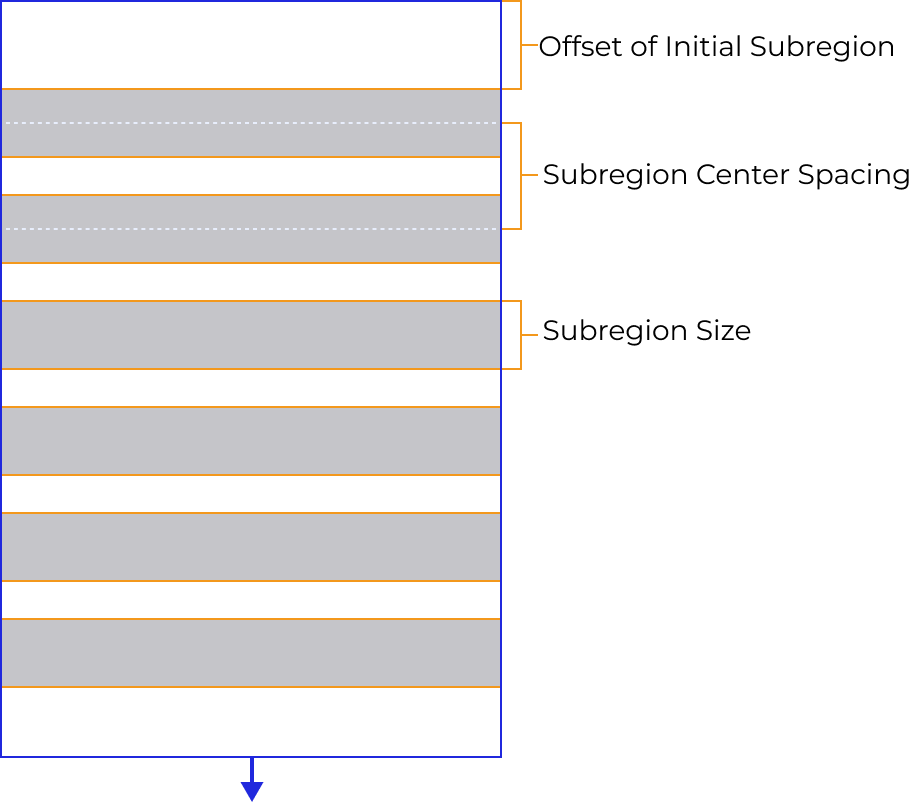Measure Regional Height
Description
Use this Step to divide the feature region into subregions and calculate the mean height, point of maximum height, and point of minimum height of the surface data in each subregion. The Step can also measure the area of the surface data in each subregion and the volume relative to the reference plane.
Workflow
The process of configuring this Step is shown below:

-
Configure the input. Connect the ports manually in the graphical programming workspace or select the input under Input in the parameter configuration panel.
-
Select the region type of the feature region under the Parameters tab.
-
Set related parameters of the subregions.
-
Select the desired output items under Output. For an expandable output item, click ▶ and configure the Min and Max values to determine the acceptable range for the item.
Input Description
| Parameter | Description |
|---|---|
Surface data |
Image data in MRAW format, including depth map and intensity image. |
Alignment Parameter Group |
The parameter group used for the translation and rotation of feature regions. See detailed information in Alignment Parameter group. |
Reference Plane |
The height, area, volume and other data are all calculated according to the reference plane. The reference plane is XOY plane when no data is inputted. |
Description
|
|
| The feature region are regions with certain directions, on which the subregions will be set. When the feature region is set as a cuboid, the direction will be displayed by an arrow in the visualizing space (Y-axis as the positive direction by default); when the feature region is set as an annular cylinder, the direction is clockwise. |
Parameter |
Description |
||
Region Type |
Set certain subregions in the feature region to calculate the height and other parameters of surface data in subregions. Options: cuboid, annular cylinder
|
||
Subregion Size |
|
||
Subregion Center Spacing |
The distance between the centers of two neighboring subregions. |
||
Offset of Initial Subregion |
This parameter is used to confirm the location of the initial subregion. |
||
Max Number of Subregions |
This parameter is to put a limitation on the number of subregions in the feature region. |
Output Description
Select the output item(s) to add the output port(s) to the Step, and the corresponding data will be output after the Step is run. You can select the output according to the actual measurement requirements.
|
If you select an expandable output item (with a ▶ on the left), you should expand it by clicking ▶, and then set the Min and Max values to determine the acceptable range. If the output value falls within the acceptable range, the measurement item is judged as passing (OK), or else it is judged as failing (NG). |
| Output item | Description |
|---|---|
Valid Point Count |
The number of valid point in subregions. |
Area above Plane |
The area of surface data above the reference plane of subregions. |
Area below Plane |
The area of surface data below the reference plane of subregions. |
Volume above Plane |
The volume enclosed by the reference plane and the surface data above it within subregions. |
Volume below Plane |
The volume enclosed by the reference plane and the surface data below it within subregions. |
Mean Height |
The average distance from the points to the reference plane within each subregion. The height value is positive when the point is above the plane, and the height value is negative when the point is below the plane. |
Points of Max Height |
Points in the subregion with the largest distance to the reference plane. The height value is positive when the point is above the plane, and the height value is negative when the point is below the plane. |
Points of Min Height |
Points in the subregion with the smallest distance to the reference plane. The height value is positive when the point is above the plane, and the height value is negative when the point is below the plane. |
Troubleshooting
|
CV-W3701
Error: The set “Region Type” is invalid.
Solution: Select a valid region type from the drop-down list.
CV-W3703
Error: The “Subregion Size” must be greater than 0.
Solution: Make sure the parameter value is greater than 0.
CV-W3704
Error: The “Offset of Initial Subregion” must be greater than 0.
Solution: Make sure the parameter value is greater than 0.
CV-W3705
Error: The “Subregion Center Spacing” must be greater than 0.
Solution: Make sure the parameter value is greater than 0.
CV-W3706
Error: The “Max Number of Subregions” value must be within 0–5000.
Solution: Make sure the parameter value is within 0–5000.

